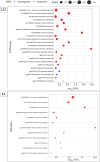Hepatic transcriptomic analysis reveals differential regulation of metabolic and immune pathways in three strains of chickens with distinct growth rates exposed to mixed parasite infections
- PMID: 39342330
- PMCID: PMC11439216
- DOI: 10.1186/s13567-024-01378-8
Hepatic transcriptomic analysis reveals differential regulation of metabolic and immune pathways in three strains of chickens with distinct growth rates exposed to mixed parasite infections
Abstract
During parasite infections, the liver may prioritise immune-related pathways over its metabolic functions. Intestinal infections caused by Ascaridia galli and Heterakis gallinarum impair feed intake, nutrient absorption, and weight gain. Histomonas meleagridis, vectored by H. gallinarum, can also damage liver tissues, potentially impairing liver functions. This study examined the hepatic gene expression in three strains of chickens: Ross-308 (R), Lohmann Brown Plus (LB), and Lohmann Dual (LD), 2 weeks after an experimental infection (n = 18) with both A. galli and H. gallinarum or kept as uninfected control (n = 12). Furthermore, H. gallinarum infection led to a co-infection with H. meleagridis. The mixed infections reduced feed intake and the average daily weight gain (P < 0.001). The infections also increased the plasma concentrations of alpha (1)-acid glycoprotein and the antibody titre against H. meleagridis (P = 0.049), with no strain differences (P > 0.05). For host molecular response, 1887 genes were differentially expressed in LD, while 275 and 25 genes were differentially expressed in R and LB, respectively. The up-regulated genes in R and LD were mostly related to inflammatory and adaptive immune responses, while down-regulated genes in LD were involved in metabolic pathways, including gluconeogenesis. Despite performance differences among the strains, worm burdens were similar, but hepatic molecular responses differed significantly. Moreover, there was an indication of a shift in hepatic functions towards immune-related pathways. We, therefore, conclude that the liver shifts its functions from metabolic to immune-related activities in chickens when challenged with mixed parasite species.
Keywords: Ascaridia galli; Heterakis gallinarum; Histomonas meleagridis; Growth performance; immune response; metabolic response; resource allocation; trade-off.
© 2024. The Author(s).
Conflict of interest statement
The authors declare that they have no competing interests.
Figures








Similar articles
-
Tissue-specific transcriptomic adaptation in three strains of chickens during coinfections with parasites.Gut Pathog. 2025 Jun 11;17(1):43. doi: 10.1186/s13099-025-00716-1. Gut Pathog. 2025. PMID: 40500794 Free PMC article.
-
Excretion of Histomonas meleagridis following experimental co-infection of distinct chicken lines with Heterakis gallinarum and Ascaridia galli.Parasit Vectors. 2021 Jun 13;14(1):323. doi: 10.1186/s13071-021-04823-1. Parasit Vectors. 2021. PMID: 34120639 Free PMC article.
-
Resistance and tolerance to mixed nematode infections in chicken genotypes with extremely different growth rates.Int J Parasitol. 2019 Jun;49(7):579-591. doi: 10.1016/j.ijpara.2019.03.001. Epub 2019 May 20. Int J Parasitol. 2019. PMID: 31121169
-
Experimental infections with the protozoan parasite Histomonas meleagridis: a review.Parasitol Res. 2013 Jan;112(1):19-34. doi: 10.1007/s00436-012-3190-5. Epub 2012 Nov 18. Parasitol Res. 2013. PMID: 23160894 Review.
-
Heterakis gallinarum, the Cecal Nematode of Gallinaceous Birds: A Critical Review.Avian Dis. 2019 Sep 1;63(3):381-388. doi: 10.1637/0005-2086-63.3.381. Avian Dis. 2019. PMID: 31967420 Review.
Cited by
-
Tissue-specific transcriptomic adaptation in three strains of chickens during coinfections with parasites.Gut Pathog. 2025 Jun 11;17(1):43. doi: 10.1186/s13099-025-00716-1. Gut Pathog. 2025. PMID: 40500794 Free PMC article.
References
-
- Rauw WM, Kanis E, Noordhuizen-Stassen EN, Grommers FJ (1998) Undesirable side effects of selection for high production efficiency in farm animals: a review. Livest Prod Sci 56:15–33
-
- van der Most PJ, de Jong B, Parmentier HK, Verhulst S (2011) Trade-off between growth and immune function: a meta-analysis of selection experiments. Funct Ecol 25:74–80
-
- Glazier DS (2008) Resource allocation patterns. Resource allocation theory applied to farm animal production. CABI, Wallingford, pp 22–43
MeSH terms
Grants and funding
LinkOut - more resources
Full Text Sources
Research Materials

